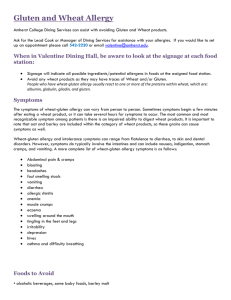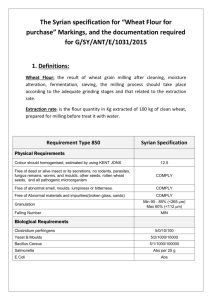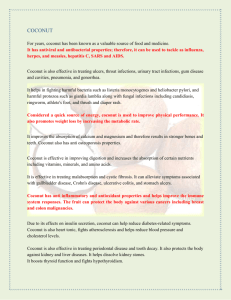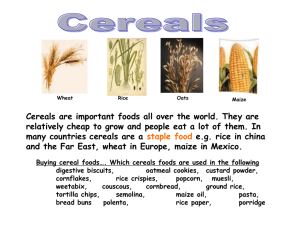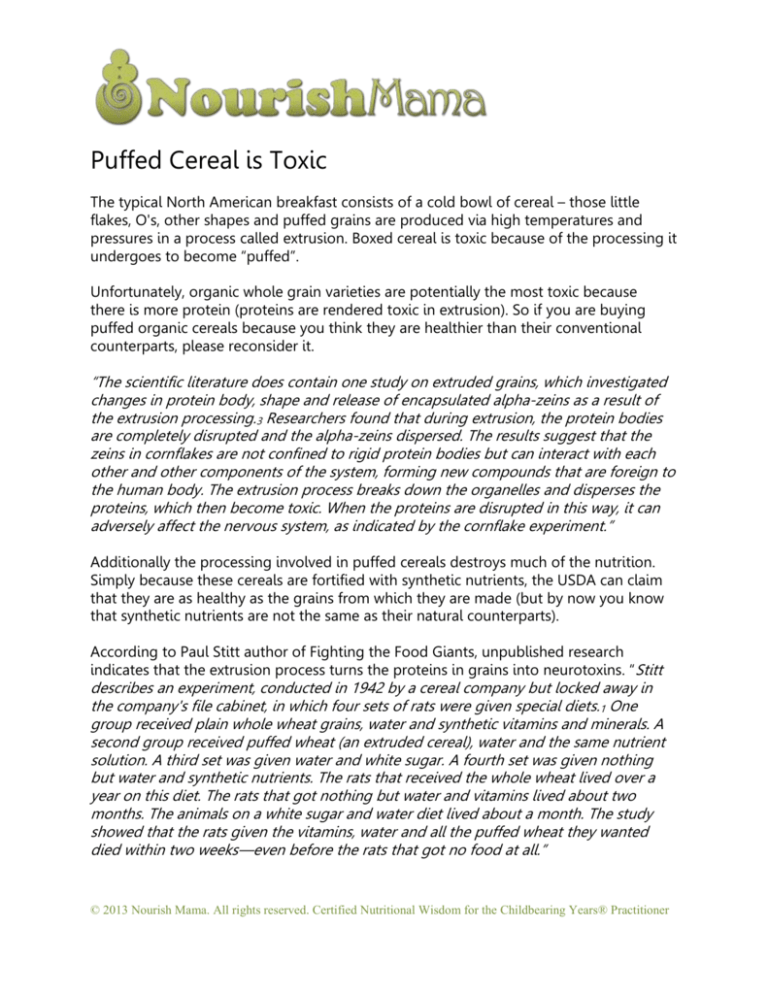
Puffed Cereal is Toxic
The typical North American breakfast consists of a cold bowl of cereal – those little
flakes, O's, other shapes and puffed grains are produced via high temperatures and
pressures in a process called extrusion. Boxed cereal is toxic because of the processing it
undergoes to become “puffed”.
Unfortunately, organic whole grain varieties are potentially the most toxic because
there is more protein (proteins are rendered toxic in extrusion). So if you are buying
puffed organic cereals because you think they are healthier than their conventional
counterparts, please reconsider it.
“The scientific literature does contain one study on extruded grains, which investigated
changes in protein body, shape and release of encapsulated alpha-zeins as a result of
the extrusion processing.3 Researchers found that during extrusion, the protein bodies
are completely disrupted and the alpha-zeins dispersed. The results suggest that the
zeins in cornflakes are not confined to rigid protein bodies but can interact with each
other and other components of the system, forming new compounds that are foreign to
the human body. The extrusion process breaks down the organelles and disperses the
proteins, which then become toxic. When the proteins are disrupted in this way, it can
adversely affect the nervous system, as indicated by the cornflake experiment.”
Additionally the processing involved in puffed cereals destroys much of the nutrition.
Simply because these cereals are fortified with synthetic nutrients, the USDA can claim
that they are as healthy as the grains from which they are made (but by now you know
that synthetic nutrients are not the same as their natural counterparts).
According to Paul Stitt author of Fighting the Food Giants, unpublished research
indicates that the extrusion process turns the proteins in grains into neurotoxins. “Stitt
describes an experiment, conducted in 1942 by a cereal company but locked away in
the company's file cabinet, in which four sets of rats were given special diets.1 One
group received plain whole wheat grains, water and synthetic vitamins and minerals. A
second group received puffed wheat (an extruded cereal), water and the same nutrient
solution. A third set was given water and white sugar. A fourth set was given nothing
but water and synthetic nutrients. The rats that received the whole wheat lived over a
year on this diet. The rats that got nothing but water and vitamins lived about two
months. The animals on a white sugar and water diet lived about a month. The study
showed that the rats given the vitamins, water and all the puffed wheat they wanted
died within two weeks—even before the rats that got no food at all.”
© 2013 Nourish Mama. All rights reserved. Certified Nutritional Wisdom for the Childbearing Years® Practitioner
These results suggest that the puffed wheat is toxic! Extrusion may produce chemical
changes that turn a nutritious grain into a poisonous substance (proteins are very
similar to certain toxins in molecularly).
Another unpublished experiment described in Nourishing Traditions by Sally Fallon was
undertaken in1960 by researchers at the University of Michigan in Ann Arbor. Eighteen
laboratory rats were divided into three groups.
“One group received cornflakes and water; a second group was given the cardboard box
that the cornflakes came in and water; the control group received rat chow and water.
The rats in the control group remained in good health throughout the experiment. The
rats eating the box became lethargic and eventually died of malnutrition. The rats
receiving the cornflakes and water died before the rats that were eating the box! (The
first box rat died the day the last cornflake rat died.) Furthermore, before death, the
cornflakes-eating rats developed aberrant behavior, threw fits, bit each other and finally
went into convulsions. Autopsy revealed dysfunction of the pancreas, liver and kidneys
and degeneration of the nerves of the spine, all signs of insulin shock.2 The startling
conclusion of this study was that there was more nourishment in the box than in the
cornflakes. This experiment was designed as a joke, but the results were far from funny.”
In conclusion it is suggested that either the box is more nutritious than the cornflakes or
the cornflakes are toxic as suggested in the first unpublished study- we have to wonder
what effect this has on our children.
Quotes excerpted from:
http://www.westonaprice.org/modern-foods/dirty-secrets-of-the-food-processingindustry
© 2013 Nourish Mama. All rights reserved. Certified Nutritional Wisdom for the Childbearing Years® Practitioner
Commercial Cereals that Are A ok
□ Oatmeal and Oat Groats
□ Holy Crap Cereal
□ Weeds and Seeds
□ Helens Seeds for Cereal
□ Ruth’s Chia Goodness
□ Q’ia
□ The Granola King
© 2013 Nourish Mama. All rights reserved. Certified Nutritional Wisdom for the Childbearing Years® Practitioner
What Else Can I eat for Breakfast Then?
Eggs:
Omelette
Quiche
Frittata
Egg Muffins
Poached Eggs
Hardboiled Eggs
Toad in A Hole
Custard
Soufflé
Raw Egg Smoothie
Scrambled Eggs
Eggs Benedict
French Toast
Pancakes:
Spelt/Coconut or
Almond Flour
Potatoe Pancakes
*Add ins to make them
more nutritious:
gravy
nutritional yeast sauce
shredded cheese
butter
coconut oil
sour cream/crème
fraiche
yogurt
cottage cheese
maple syrup # 3 (the
most minerals)
bananas, squash,
pumpkin
chia/flax and other
seeds
nut and seed butters
protein powder
leftover grains
Oats:
Oatmeal
Oat Groats
Leftover Oatmeal Cakes
Sauteed in Butter
Homemade Granola
*Add ins to make them
more nutritious:
butter
coconut oil
unrefined salt
cinnamon
flax oil/hemp oil
chia/hemp etc. seeds
nut and seed butters
yogurt
Meat:
Green Eggs and Ham
Bacon & Eggs
Liver pate or patties
Sausage
Turkey Patties
Steak and Potatoes
Other:
Vegan Pate on Crackers
Hummous on Crackers
Vegetable Hash
Scrambled Tofu (use
tofu made with
fermented and/or
sprouted soy)
Dragon Bowl
Miso or other soup
Millet Cheesecake
Sandwiches
Porridge, Crockpot or
Cream of Seed Cereal:
Oats
Millet
Amaranth
Buckwheat
Quinoa
Barley
Smoothies
Fruit
Protein
Green
*Add ins to make them
more nutritious:
coconut oil
Udo’s Oil
flax oil/hemp oil
chia/hemp etc. seeds
nut and seed butters
yogurt
raw eggs
spirulina
Homemade Cereals:
Seed Granola
Chia Cereal
Puffed Amaranth
Yogurt parfaits
© 2013 Nourish Mama. All rights reserved. Certified Nutritional Wisdom for the Childbearing Years® Practitioner
How to Bake With Alternative Flours
You might imagine that living without wheat would make for a pretty limited diet, but
what we’ve found is - that the foods we make with the alternative flours we recommend,
are actually just as good as, if not more enjoyable than their wheat counterpart!
Spelt –Replace it cup for cup in baking (plus an extra ¼ cup for bread making).
Spelt is an ancient grain related to wheat, yet it is moister and tastes sweeter. Many
people who don’t digest wheat well, do fine with spelt (but it does have gluten). Spelt is
not hybridized and is much easier to digest, not to mention being higher in both
protein and B-Vitamins, than wheat. In our experience, you can you use it 1:1 in cookies,
cake and muffins that call for wheat.
Almond Flour – use about 1cup to 1 ½ cups more (seem to need to use even more
when using Bob’s Red Mill brand than others).
Almond flour is a super nutrition alternative to cooking with grains. In many recipes, you
can hardly tell that it isn’t wheat! Unlike coconut flour, you don’t have to use a lot of
eggs and sometimes none at all. Almond flour has 6 - 7 times more minerals than wheat
flour and 3 times more iron.
In order to use almond flour, it really helps to have a recipe, but you can always take a
conventional recipe and simply mix up your wet ingredients first and then stir in the
almond flour until it is the consistency you would usually expect in your wheat version.
Coconut Flour –use way less coconut flour than wheat flour and add plenty more eggs.
Coconut flour is 14% oil and 58% digestible fiber, with the remaining portion a
combination of water protein and carbohydrate. It is gluten free. Coconut flour absorbs
A LOT of water so you only need to use a little. For example for a whole cake you would
only need ¾ cup of coconut flour and about 9 eggs.
© 2013 Nourish Mama. All rights reserved. Certified Nutritional Wisdom for the Childbearing Years® Practitioner
How to Cook Seed Grains
Amaranth (Aztec)
High in protein, Iron and Zinc. Contains more of the beneficial amino acids lysine and
methionine.
Cook 1 cup grain & ½ tsp salt to 2 ½ cups water/broth (or 3 cups for a more porridge
like texture)
or
Pop like popcorn and enjoy as a snack with butter or as a breakfast cereal served with
hemp milk. Pop 2 Tbsp at a time (makes about ½ cup).
Buckwheat (not part of the wheat family, it is from a seed bearing herb related to
rhubarb & sorrel)
Rich in Lysine. High levels of protein, calcium, magnesium, phosphorus, B-vitamins &
iron.
Rinse 3 times in water or roast (Kasha).
Method 1:
1 cup buckwheat & ½ tsp salt, to 2 cups water. Bring to a boil, add 1 Tbsp butter, then
add buckwheat and cook for 15 min. Then let sit for 10 min. Alternate: To firm it`s
texture, slowly cook the buckwheat in a shallow sauce pan. This will cause the
buckwheat to absorb less liquid. Buckwheat are soft even when raw, so overcooking the
grain could turn it to mush.
Method 2:
Whisk 1 egg. Coat a large pan with butter or coconut oil and heat to med. Add 1 cup
toasted buckwheat.
Add the beaten egg to the pan and stir it quickly into the groats to prevent the egg
from congealing into a large mass (egg helps to keep the buckwheat groats from
sticking together).
Stir until the mixture is dry and the grains are well separated.
© 2013 Nourish Mama. All rights reserved. Certified Nutritional Wisdom for the Childbearing Years® Practitioner
Add two cups of water, stock, or broth. Reduce the heat to low, cover, and simmer for
fifteen minutes (or until the buckwheat has absorbed all of the liquid).
Remove from the heat and allow it stand (covered) for five minutes.
Fluff it with a fork and season it with salt, pepper and spice of your choice.
Millet (easy to digest and considered one of the least allergenic grains)
High in iron and magnesium. It is also high in calcium, phosphorus, manganese, zinc,
and B vitamins.
Toast first for firmer texture.
½ cup millet & 1/4 tsp salt to 1 ½ cups liquid. Bring to a boil and simmer for 25 min.
Add 2 Tbsp millet to muffins for a nice crunchy texture.
Quinoa (Incas)
Loaded with protein and lysine. Also high in iron, calcium, zinc, potassium, magnesium,
phosphorus and copper.
Rinse quinoa vigorously in a mesh strainer.
Toasting quinoa in a skillet with a little bit of coconut oil or butter over low heat for a
few minutes before adding it to boiling water to give quinoa a nutty flavor. Stir it
constantly for 6-8 minutes (so that it doesn’t burn) but turns golden.
Bring 1 cup of quinoa & ½ tsp salt to 2 cups water to a boil and simmer for
approximately 20min.
© 2013 Nourish Mama. All rights reserved. Certified Nutritional Wisdom for the Childbearing Years® Practitioner


